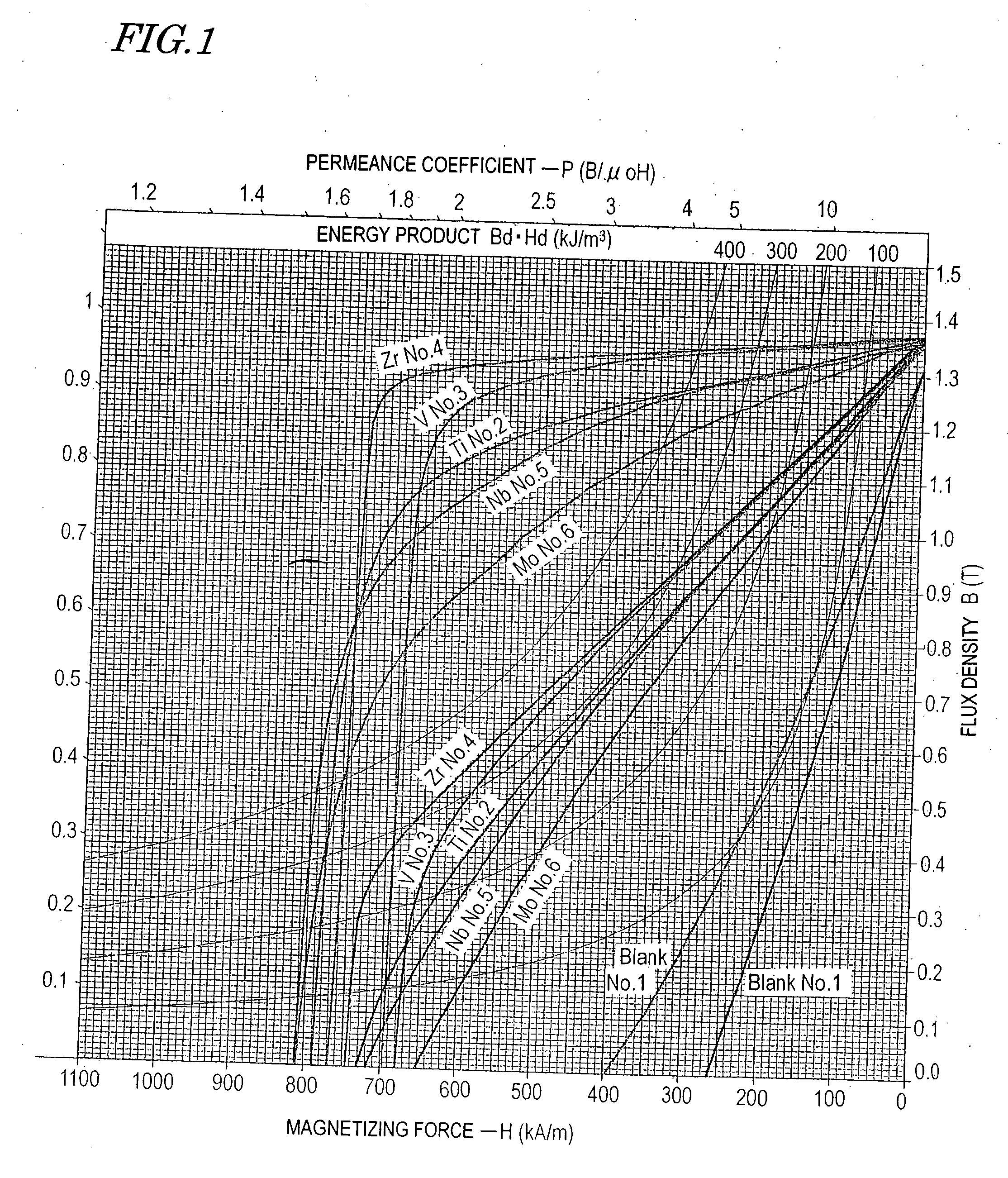R-t-b sintered magnet and rare earth alloy
- Summary
- Abstract
- Description
- Claims
- Application Information
AI Technical Summary
Benefits of technology
Problems solved by technology
Method used
Image
Examples
experimental example no.1
EXPERIMENTAL EXAMPLE NO. 1
[0058] Magnets having the compositions shown in Table 1 were made in the following manner as Samples Nos. 1 through 6, respectively. It should be noted that the compositions shown in Table 1 are values obtained by analyzing the resultant sintered magnets, not the compositions of the mother alloys. The composition analysis was carried out by a known method using an ICP produced by Shimadzu Corporation and a gas analyzer produced by Horiba, Ltd.
[0059] In Table 1, Fe is shown as the balance. Actually, however, the balance includes Fe and very small amounts of inevitably contained impurities. The same statement will apply to Table 3 to be mentioned later.
[0060] In each of the samples representing this experimental example, the mass fraction of B substantially agrees with its stoichiometric ratio defined with respect to the mass fractions of R and T. Also, calculating the volume percentages of the respective phases with the additive element M taken out of cons...
experimental example no.2
EXPERIMENTAL EXAMPLE NO. 2
[0081] Magnets having the compositions shown in the following Table 3 were produced by the same method as that used in Experimental Example No. 1. In this example, however, the concentration of oxygen in the atmospheric gas was controlled to 50 ppm or less in the fine pulverization process in order to reduce the content of oxygen in the resultant sintered magnet. These samples Nos. 7 through 20 prepared in this manner were sintered at various sintering temperatures, thereby obtaining sintered magnets, of which the properties were evaluated as shown in the following Table 4. In Table 4, each item was evaluated as in Experimental Example No. 1 described above.
TABLE 3SampleNdFeCoAlCuZrGaBOCNNo. 729.3Bal.0.880.160.09——1.020.220.060.011No. 829.4Bal.0.870.150.10——0.980.210.050.010No. 929.2Bal.0.880.150.09——0.960.220.060.010No. 1029.2Bal.0.880.160.09——0.940.220.060.011No. 1129.2Bal.0.890.160.10——0.900.210.070.010No. 1229.3Bal.0.870.160.100.10—1.020.220.060.011No...
experimental example no.3
EXPERIMENTAL EXAMPLE NO. 3
[0092] Sintered magnets, having a composition consisting of 22.0 mass % of Nd, 6.2 mass % of Pr, 2.0 mass % of Dy, 1.8 mass % of Co, 0.10 mass % of Cu, 0.94 mass % of B, 0.05 mass % of Ga, X (0 to 4) mass % of Zr, and Fe and inevitably contained impurities as the balance, were produced at various sintering temperatures by the same method as that adopted in Experimental Example No. 1 and the magnetic properties thereof were evaluated. The sintered magnets produced in this Experimental Example No. 3 had an oxygen content of 0.38 mass % to 0.41 mass %.
[0093]FIG. 16 is a graph showing how the magnetic properties changed with the mass fraction of Zr in two situations where the sintering temperatures were 1,060° C. and 1,080° C., respectively. In FIG. 16, the abscissa represents the Zr mass fraction, while the ordinate represents Hk (which is the strength of an external magnetic field when the magnetization becomes 90% of the remanence Br), coercivity HcJ and re...
PUM
| Property | Measurement | Unit |
|---|---|---|
| Percent by mass | aaaaa | aaaaa |
| Percent by mass | aaaaa | aaaaa |
| Percent by mass | aaaaa | aaaaa |
Abstract
Description
Claims
Application Information
 Login to View More
Login to View More - R&D
- Intellectual Property
- Life Sciences
- Materials
- Tech Scout
- Unparalleled Data Quality
- Higher Quality Content
- 60% Fewer Hallucinations
Browse by: Latest US Patents, China's latest patents, Technical Efficacy Thesaurus, Application Domain, Technology Topic, Popular Technical Reports.
© 2025 PatSnap. All rights reserved.Legal|Privacy policy|Modern Slavery Act Transparency Statement|Sitemap|About US| Contact US: help@patsnap.com



